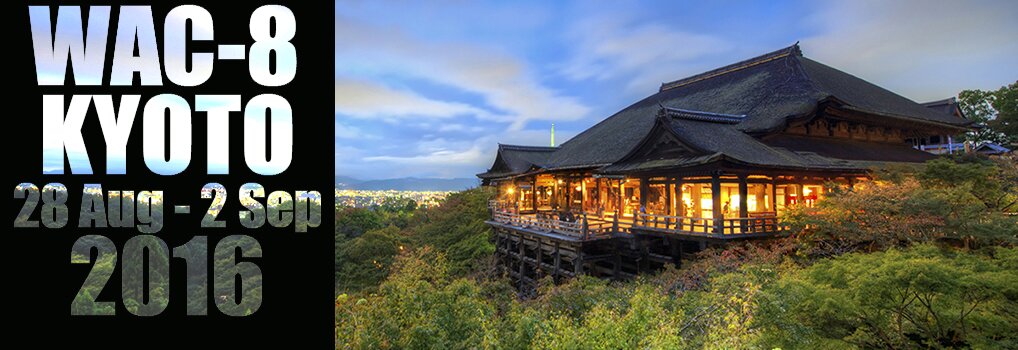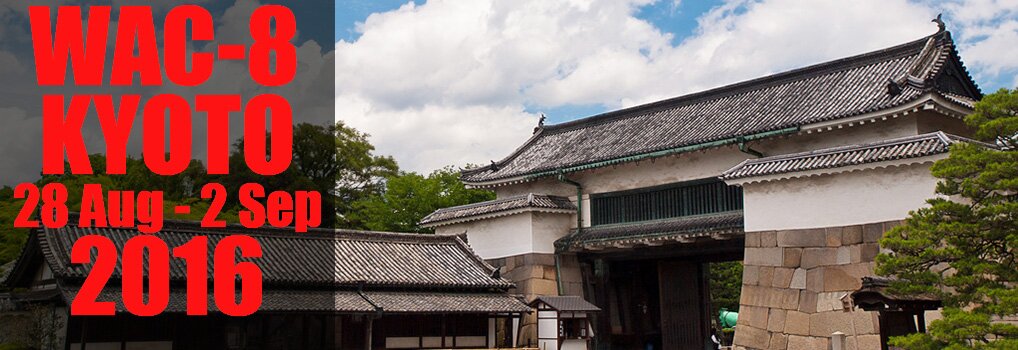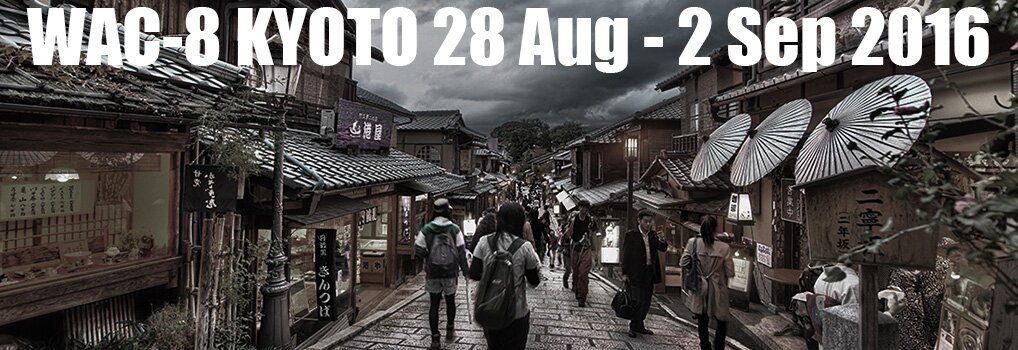| T01 | T02 | T03 | T04 | T05 | T06 | T07 | T08 | T09 | T10 | T11 | T12 | T13 | T14 | T15 |
| Theme list | Session organizers index | Accepted sessions list |
| T15. War and Conflict Friedrich Schipper |
|---|
| The WAC community has dealt with the theme of the destruction of cultural heritage during armed conflict at least for the past two congresses (Dublin and the Dead Sea) as well as three inter-congresses (Ramallah, Vienna and Rome). In the meanwhile, it has become a permanent topic of academic discourse. As a result of this intensive and sometimes controversial process, WAC has recently adopted a new accord: “The WAC Accord on the Protection of Cultural Property in the Event of Armed Conflict” or, for short “The Dead Sea Accord”. This is a milestone. But what next? At the base of the Dead Sea Accord is the belief that culture, including knowledge, history, traditions, language, adaptations, technology, art, literature, architecture and material culture – in short, both portable and non portable, both tangible and intangible – is a basic human right. WAC’s focus on the protection of material culture as a subcategory of culture makes it clear that human life is always a priority. But this does not discount the significance of material culture – rather it makes the connection between humans and all aspects of their culture very clear. Meanwhile, the destruction of cultural heritage in armed conflict has turned to a renaissance of iconoclasm beyond all legal and ethical norms. Prominent representatives of civil society publicly label this destruction as a war crime or crime against humanity. And the current events worldwide demonstrate the interdependence between ethnic and cultural cleansing. As a community, we, our discussions, our papers and our accords are at the cutting edge of contemporary controversy and ethics. At upcoming WAC-8 we will again strive for engaging a broad range of questions, including philosophical, ethical, juridical, humanitarian, social, sociological, psychological, humanistic, historical, religious, cultural, economic, political, and military aspects in order to face the new reality, dimension and nature of cultural heritage destruction and to define our role and tasks as a scientific community in helping to protect what we try to explore. |
Cancelled
The reflection and effects of Arab spring on archaeological and cultural heritage sites of Arab world
Organiser(s): Ahmed Alsherif (Sabha University / Libya)
Type: Symposium
Contact: alsherif76(at)gmail.com
Abstract:
This paper examines the impacts of Arab spring on archaeological and cultural heritage of Arab countries. Arab spring is term known by journalists that refers to a revolutionary wave of demonstration, wars, and protests, ongoing, armed and internal conflicts occurring in the Arab world that began on December 18, 2010. For instance in Libya treasure of Benghazi around 8000 bronze silver and gold coins and other artifacts from Cyrene (Shahhat), it was disappeared from the national commercial bank of Benghazi. On the other hand, Jihadists have destroyed hundreds of rival Muslim sites such as Sufi shrine in Libya to revered tombs in Syria and Iraq.
Egypt: Looters attacked many archaeological sites such as Abydos, Abu Sir, Giza, Dashur, Lisht, Saqqara, and Quntara. Thieves pilfered artifacts from Egyptian museum in Cairo.
Syria: By September 2011 the looters had hit the Seleucid city Apamea, it is located northwest of Hama, by 2015 began destruction of the UNESCO World Heritage sites in Palmyra.
Iraq: vandalizing and looting the world heritage sites of Mosul Museum, libraries, Nimrud, Nineveh, Hatra, and destroying ancient religious sites by ISIS. The paper uses distribution map of archaeological and cultural sites to determine the percentage of distraction of that sites.
Keywords: Arab spring, impacts, heritage
Cancelled
Defiling the Bride of the Desert- Serious Damage and Loss of Heritage in Syrian Conflict
Organiser(s): Tushar Saha (Kenyatta Uinversity / Kenya) and Idun Yvonne (Kenyatta Uinversity / Kenya)
Type: Symposium
Contact: drtksaha(at)gmail.com
Abstract:
Syria’s archaeological heritage is imperiled by war, facing threats ranging from outright destruction by bombs and bullets to opportunistic digging by treasure hunters (grave sites are potential spots to find jewelry or figurines, as some corpses were interred with offerings and possessions) who take advantage of the power vacuum to prowl the country with spades and shovels. Damage has already been caused to numerous historic buildings in Syria telling tons on history. Many monumental archaeological locations, including all six UNESCO World Heritage Sites in the country disappeared. Destructive effects of the conflict are caused by shelling, looting and army or militias occupation. The destruction and fire that burnt the ancient souk in the old city of Aleppo that is regarded as “crossroads of cultures since the 2nd millennium BC” is a colossal loss forever. Many locations declared as endangered sites by the UNESCO in 2013 now turned into rubbles. All parties involved, violated the Hague Convention of 1954 on the protection of cultural property in the event of armed conflict. No serious efforts have been made to protect Aleppo’s heritage and to mitigate the effects of the cultural disaster and to avoid further damage. Shelling destroyed WHS like KCD, Archaeological Village of Northern Syria, Bosra, Roman Ruins of Palmyra (Bride of the Desert), Old city of Damascus, Medieval buildings in the Ancient city of Aleppo, Great Mosque and Al Medina Souq of Aleppo among many others. Looting spree grabbed twenty five cultural heritage museums dispersed around Syria, many with artifacts stored outside. The museum at Homs has been looted and that only the museums and monuments of Damascus are safe from looting and destruction from the escalating warfare between government and armed rebel militias. Indeed, the country threatened by armed criminal groups with hi-tech tools and specialized in the theft of manuscripts and antiquities, as well as the pillaging of museums has become real. Damage to ancient sites has also been caused due to army occupation by encampments, entrenchment of military vehicles and weapons and during movement of materials for construction, souvenirs or even target practice. The history and heritage are replaced by another different history of modern warfare that clocks back in negative reversals of civilisation.
Keywords: Power, People and Heritage
Armed Conflicts, Faith (religion) and the Question of Heritage and Identity.
Organiser(s): Caleb Adebayo Folorunso (University of Ibadan / Nigeria), Zacharys Anger Gundu (Ahmadu Bello University / Nigeria) and Gunes Duru (Galatasaray University / Turkey)
Type: Forums
Contact: cafolorunso(at)gmail.com
Abstract:
Climates of war and violence have been responsible for the loss of about 50% of all global cultural property by UN estimates. The 2nd World War witnessed the largest organized looting and destruction of heritage collections in history. Global response led to the 1954 Hague Convention for the Protection of Cultural Property in the Event of Armed Conflict, however current dynamics and global trends in conflict have added new dimensions to the problems of protecting heritage resources and identity in today’s corridors of conflict. Different threats and challenges have continued to play out in Afghanistan, Pakistan, Iraq, Syrian, Egypt, Mali, Nigeria and former Yugoslavia. Religious faith appears to be a strong factor among others for the destruction of sites, monuments, libraries and archives, looting and illicit sales of antiquities by terror rings and ‘identity cleansing’. The threats have made archaeological field work difficult and very dangerous in certain parts of the world. The threats have complicated conservation and access to archaeological sites and tourist destinations. The proposed session attempts to bring together archaeologists and other stakeholders to discuss and share thoughts on the emerging new threats and suggest future mitigation plans, considering such new lexicons like ‘asylum for cultural properties’.
Keywords: Heritage and Identity, war and violence, conflict corridors.
Contesting Area C: Archaeology in the West Bank, Occupied Palestinian Territories
Organiser(s): Brian Boyd (Columbia University / USA) and Hamed Salem (Birzeit University / Palestinian Territories)
Type: Workshop
Contact: brian.boyd(at)columbia.edu
Abstract:
Recently, much has been written in the popular media and in academic publications about the ongoing archaeological excavations by Israeli institutions in the occupied Palestinian Territories. Understandably, these writings have largely focused on archaeological interventions in East Jerusalem and other high profile sites such as Hebron. However, as the recent West Bank and East Jerusalem Archaeological Database Project (published 2009) has documented in some detail, Israeli archaeological institutions (sometimes with foreign partners and/or funding) have been carrying out extensive survey and excavation work throughout the entire West Bank since the establishment of military occupation in 1967.
This discussion workshop focuses on three main issues:
1. The central role of the Archaeology Department of the Civil Administration in Judea and Samaria – in all West Bank archaeological matters, and the relationship of the ADCA to Israeli military administration.
2. Excavations carried out in the context of (internationally-regarded) illegal settlement building and expansion, and the construction of the Separation Barrier, in Area C (i.e. the parts of the West Bank under full Israeli jurisdiction).
3. The neglect and destruction of archaeological sites and cultural heritage in Area C that are not regarded as being part of the Israeli government’s strategic vision for a national State.
Keywords: Palestine, Settlements, Excavations
Socially Mediated Terrorism, the Islamic State/Da’esh and Cultural Heritage
Organiser(s): Claire Smith (Flinders University / Australia) and Dima Chahin (Norwegian Institute for Cultural Heritage Research / Norway )
Type: Symposium
Contact: claire.smith(at)flinders.edu.au
Abstract:
In 2004, the Parliamentary Assembly Council of Europe noted that ‘culture is … becoming increasingly a target of terrorism’.
In 2016, it is possible to identify the genesis of a new form of terrorism—socially mediated terrorism— in which the imaginative capacities of networked and social media are exploited to increase the impact of terrorist actions. While iconoclasm has a lengthy history, the primary aim of cultural heritage destruction has been the subjugation of local populations/audiences. In contrast, the Islamic State/Da’esh’s destruction of cultural heritage—and other terrorist actions—have been amplified through networked and social media. These actions are directed simultaneously towards local, regional and international audiences with reactions from one audience used to subdue, embolden or intrigue another.
The visual, symbolic nature of cultural heritage is making this heritage particularly vulnerable to those seeking to attract global attention. Accordingly, this session will focus on the ways in which the Islamic State uses the destruction of cultural heritage to further its goals in relation to local, regional and international audiences. In addition, we seek papers on other uses of cultural heritage by the Islamic State, such as financing the Kaliphate.
Keywords: socially media, terrorism, Islamic State, Da’esh, cultural heritage
Cancelled
Archaeological Sites at Risk: The Urgent need for documentation & Protection
Organiser(s): Mariam Al-Mulla (Qatar University / Qatar) and Mahjoob Al-Zwir (Qatar University / Qatar)
Type: Symposium
Contact: malmulla(at)qu.edu.qa
Abstract:
Archaeological sites are among the most priceless and irreplaceable possessions, not only of each nation, but of mankind as a whole. Their loss, through deterioration, destruction or disappearance, of any of these most prized possessions constitutes an impoverishment of the heritage of all the peoples in the world. Parts of that heritage, because of their exceptional qualities, can be considered to be of outstanding universal value and as such worthy of special protection against the dangers which increasingly threaten them. Despite the significant work done by organisations such as UNESCO, and national preservation organisations, we are now facing in the Middle East a seemingly uncontrollable process of deliberate destruction of heritage sites, making the need to work together across national borders to try and find solutions.
Islamic State militants have destroyed the ancient city of Hatra, founded during the Parthian Empire over 2,000 years ago. Militants have recently bulldozed ruins at the Assyrian city of Nimrud, an Assyrian city founded in the 13th Century BC, and destroyed museum artefacts in Mosul. In Syria fighting destroys ancient Muslim shrines in Palmyra. ISIS militants are reported to have rigged the ruins with large quantities of explosives before detonating them. ISIS is known to be funding itself though the illegal sale of artefacts from these and other sites.
In Egypt, archaeological sites and museum objects have been laundered Looting of ancient Egyptian treasures by organized syndicates and enterprising villagers has been occurring at a frantic pace since the first days of the nation’s uprising in 2011. Religious and cultural heritage have been ruined by Yemen’s war, attacks have destroyed the Dhamar museum, which housed over 12,000 artefacts, historic caked-mud high-rise dwellings, 12th century citadels and minarets and other places. The Great Dam of Marib, built 2,800 years ago, has been struck four times and air attacks on the archaeological excavation sites at Baraqish and Sirwah, both impressive pre-Islamic walled cities.
All of these examples demonstrate the urgent need to document and protect such archaeological sites.WAC8 invite you to use this opportunity to share stories of threat and exchange experiences in archaeological site protection across international borders in an environment sensitive to cultural and religious difference.
The session themes will focus on a broad range of topics related to archaeological Sites at Risk, Urgent need for Documentation & Protection, including (but not limited to):
• Archaeology between armed conflicts and wars
• Archaeology and plunder during civil disorder
• Reducing damage threatening archaeological sites before, during and after the destruction have taken place
• Programs of documenting archaeological sites under threat
• Use of knowledge, innovation and education to build a culture of disaster prevention.
• Sectarianism and extreme violence against archaeological sites
• Archaeology and political ideologies
• Archaeology and religion
• Archaeology and changing social and economic conditions in countries
• The market for trafficked antiquities from museums or archaeological sites
Keywords: Archaeological sites, priceless,archaeology deterioration
T15-G
Archaeological Sites at Risk: The Urgent need for documentation & Protection
Organiser(s): Mariam Al-Mulla (Qatar University / Qatar) and Mahjoob Al-Zwir (Qatar University / Qatar)
Type: Symposium
Contact: malmulla(at)qu.edu.qa
Abstract:
Archaeological sites are among the most priceless and irreplaceable possessions, not only of each nation, but of mankind as a whole. Their loss, through deterioration, destruction or disappearance, of any of these most prized possessions constitutes an impoverishment of the heritage of all the peoples in the world. Parts of that heritage, because of their exceptional qualities, can be considered to be of outstanding universal value and as such worthy of special protection against the dangers which increasingly threaten them. Despite the significant work done by organisations such as UNESCO, and national preservation organisations, we are now facing in the Middle East a seemingly uncontrollable process of deliberate destruction of heritage sites, making the need to work together across national borders to try and find solutions.
Islamic State militants have destroyed the ancient city of Hatra, founded during the Parthian Empire over 2,000 years ago. Militants have recently bulldozed ruins at the Assyrian city of Nimrud, an Assyrian city founded in the 13th Century BC, and destroyed museum artefacts in Mosul. In Syria fighting destroys ancient Muslim shrines in Palmyra. ISIS militants are reported to have rigged the ruins with large quantities of explosives before detonating them. ISIS is known to be funding itself though the illegal sale of artefacts from these and other sites.
In Egypt, archaeological sites and museum objects have been laundered Looting of ancient Egyptian treasures by organized syndicates and enterprising villagers has been occurring at a frantic pace since the first days of the nation’s uprising in 2011. Religious and cultural heritage have been ruined by Yemen’s war, attacks have destroyed the Dhamar museum, which housed over 12,000 artefacts, historic caked-mud high-rise dwellings, 12th century citadels and minarets and other places. The Great Dam of Marib, built 2,800 years ago, has been struck four times and air attacks on the archaeological excavation sites at Baraqish and Sirwah, both impressive pre-Islamic walled cities.
All of these examples demonstrate the urgent need to document and protect such archaeological sites.WAC8 invite you to use this opportunity to share stories of threat and exchange experiences in archaeological site protection across international borders in an environment sensitive to cultural and religious difference.
The session themes will focus on a broad range of topics related to archaeological Sites at Risk, Urgent need for Documentation & Protection, including (but not limited to):
• Archaeology between armed conflicts and wars
• Archaeology and plunder during civil disorder
• Reducing damage threatening archaeological sites before, during and after the destruction have taken place
• Programs of documenting archaeological sites under threat
• Use of knowledge, innovation and education to build a culture of disaster prevention.
• Sectarianism and extreme violence against archaeological sites
• Archaeology and political ideologies
• Archaeology and religion
• Archaeology and changing social and economic conditions in countries
• The market for trafficked antiquities from museums or archaeological sites
Keywords: Archaeological sites, priceless,archaeology deterioration




